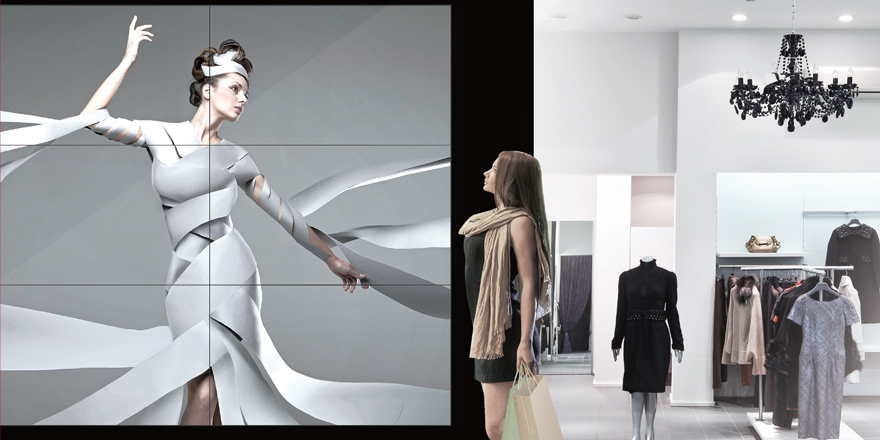We don’t think there’s a definite answer to this question. That’s because a lot depends on a business’s particular needs and goals for a video wall and the environment in which it will be used. No doubt about it, the sheer beauty of a massive video wall is very effective at attracting and engaging viewers by providing an immersive visual experience.
Let’s look at today’s leading video wall technologies:
Liquid Crystal Display (LCD). Many of the video walls seen in numerous businesses today use LCD panels. Because liquid crystals do not emit their own light, the LCD panels must utilize a light source behind or at the edges of the LCD glass. A lot of the large-scale LCDs used in video walls today are LED (Light Emitting Diode) backlit, and for that reason are referred to as LED displays. The LEDs are used to provide a white light, which then shines through the rapidly-refreshing LCD shutter array which tints the emanating light.
In the digital signage industry you’ll hear video walls described as 3×3, 5×5, 7×5 and much higher. This is not referring to the dimensions but rather the number of panels tiled together horizontally and vertically to make one very big screen. Leading video wall manufacturers are featuring thinner and thinner bezels, currently under 2 mm measured bezel-to-bezel, and LG will be introducing significantly thinner bezels soon. Other offerings remove the metal bezels altogether in an effort to present a barely visible seam where the panels meet.
Organic Light Emitting Diode (OLED). The OLED technology used for video wall panels offers amazing advancements in both picture quality and panel design. No extra lighting unit and shutter array are required, and each OLED pixel can be turned off completely to reproduce the color black. Because of this OLED is able to render perfect black, which can enable infinite contrast. Without the backlight and shutter array an OLED video wall panel can be astonishingly thin – a single LG 65” OLED panel, for example, is a mere 6 mm (0.2”) deep and weighs just 29.8 lbs. LG’s Open-Frame OLED panels are also able to be curved into concave or convex installations. Minimal space is required, as the tiled displays blend in with the wall and a flat ribbon cable connects to the signage box elsewhere.
Direct View LED (DVLED) video walls have been around for many years and are often seen in stadiums and as billboards. But DVLED technology has undergone recent improvements to the point that we now have indoor ultra-fine pitch DVLED modules with pixel pitches of 1.0, 1.5 and 2.0 mm, and high brightness of 1,000 or more nits. That means a great-looking picture when viewed from close distances. DVLED modules do not require backlighting or edge-lighting assemblies, and when joined together create a seamless look. Ultra-fine-pitch video walls allow for a much wider range of uses including projector replacement, LCD/LED video wall replacement and as digital signage displays. They’re often recommended for automotive and industrial product showrooms, museums and galleries, control rooms, boardrooms and broadcast studios. To learn about LG’s DVLED and what pixel pitch means for image quality and viewing distance, check out our blog post from January 12, 2018 here.
Rear-Projection Cube technology has been widely used to create control room video walls, as flat panel video wall displays used to be more expensive than equivalent cubes and offered fewer features. The bezel thickness of a cube is typically less than 0.25 mm, thereby virtually avoiding image information loss, and has given cubes an advantage in certain situations such as military control rooms and broadcasting stations, despite shortcomings that can include the need to install a separate cooling system and regular replacement of lamps, color wheels and filters.
Here’s the bottom line: Unlike years ago, today’s consumers are accustomed to watching large, high-resolution, flat-panel TVs in their own homes. It’s going to take a lot more to wow them when they’re out. And so video walls are likely to increase in demand for attracting attention in all kinds of public spaces. Even the video walls themselves are being creatively designed – tiled asymmetrically or curved into environments all their own – in the quest to create more exciting viewing experiences. So when we’re asked which video wall technology is best, our answer is usually, “Let’s talk.”
